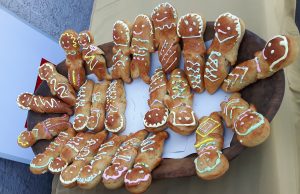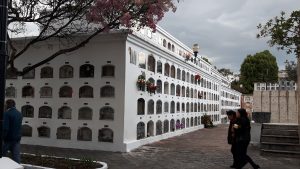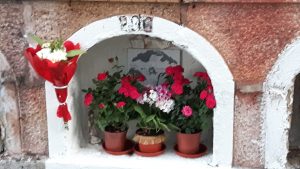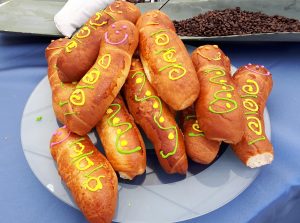Guaguas de Pan and Colada Morada

Guaguas de Pan, Cuenca, Dia de Difuntos
Guaguas de Pan and Colada Morada: Dia de Difuntos Celebration
For North American expats in Ecuador’s highlands, trick or treating ghosts and goblins are replaced by guaguas de pan, colada morada, and visits to the cemetery this time of year. The early Christian holidays of All Hallows’ Eve, All Saints’ Day, and All Souls Day, which occur back to back, were transported to North and South America with different results. While Halloween is celebrated on All Hallows Eve, Oct 31, and originated in Irish and British costumed “battles” between saints and sinners, Ecuador’s Dia de Difuntos, Day of the Deceased, or Day of the Dead, is celebrated on All Souls’ Day, Nov 2 and originates in Catholic beliefs that those in purgatory need help from the living to get into heaven.1 In Ecuador the Catholic rituals were blended with native Andean beliefs in the power of ancestors.

Municipal Cemetery, Cuenca, one day before Dia de Difuntos
Guagua de pan (Quichua; Spanish — guagua is pronounced ‘wawa’) and tantawawa (Quichua) translate to “bread baby.” Guaguas de pan are an Andean tradition found from southern Columbia to NW Argentina, with local variations .2 This native, rural tradition has merged with the urban. About 2 weeks before Dia de los Difuntos, bakeries in Cuenca, Quito, and other highland cities begin to stock these bread rolls shaped like a swaddled baby – with a head and a body but no legs or feet. Indigenous babies are traditionally tightly bound in cloth virtually 24/7, so this is what indigenous babies look like!

Flowers placed in a crypt, Municipal Cemetery
Why are bread babies made at the same time indigenous people are visiting the cemetery? Based on my observations at an indigenous cemetery during Easter near Otavalo in 1976 and referenced sources, it appears that the bread is one of many offerings to deceased relatives, with whom living families want to maintain a strong relationship. At the indigenous cemetery I visited, entire families brought bountiful food to the cemetery and ate by their ancestors’ graves, sharing the food and drink with them. The deceased were treated as if they were living. The cemetery atmosphere was not somber, as in North America, but completely relaxed and festive. The same happens on Dia de Difuntos. In Bolivia and NW Argentina, tantawawakuna (bread babies) are also made during Carnival.

Tantawawakuna, or Guaguas de Pan
Why babies? I can only speculate. In other parts of Peru’s Andes, bread horses and llamas, needed to cross rivers in life after death, and bread stairs with which to reach heaven, are among offerings to the deceased on Dia de Difuntos. What more precious thing to give than a baby? In Ecuador, Colombia and Peru tantawawakuna are exchanged among native families to cement family and compadrazgo relationships. How else to cement a relationship with powerful ancestors but to offer the same?
Modern day versions of tantawawakuna include colored icing to dress up the face and body. They are served in panaderias and cafes with colada morada. I’ve not tasted the bread due to my wheat allergy, but the one John ate tasted like a scone. Recipes probably vary.
Just as trick or treating for candy has come a long way from its origins so has the tantawawa.
Colada Morada

colada morada
As best I can determine, colada morada (purple colada), is a highland Ecuadorian tradition not found in other parts of the Andes.3 The preparation and cooking of this thick drink must be time consuming. It has a long list of ingredients: black corn flour, naranjilla (tart, acidic fruit with orange skin), mora (Andean blackberry), pineapple, babaco (seedless fruit with unique flavor and texture), strawberries, spices – ishpingo (South American tree with cinnamon aroma), cinnamon, allspice, clove – and leaves of the orange tree, hierba luisa (lemon bee bush), and arrayan (Chilean myrtle). 4
I have yet to find a trustworthy explanation for the significance of the colada morada. I have tasted this drink and found it overly sweet, but am sure there is variation in recipes.

Homemade Sign at Fair
Footnote 1: http://www.catholic.org/news/hf/faith/story.php?id=65067
Footnote 2: https://es.wikipedia.org/wiki/Guaguas_de_pan I regret that I do not have better source material. The internet is filled with undocumented opinions about the subject. For example, one “expert” interviewed in an Ecuadorian newspaper declared that colada morada is over 5,000 years old. Really? He has archeological evidence? I have drawn from the Wikipedia article on “guaguas de pan” which references 9 anthropological sources.
Footnote 3: https://es.wikipedia.org/wiki/Colada_morada
Footnote 4: Ingredients of Colada Morada: http://www.ecuaworld.com/ecuablog/index.php?itemid=206
Category: Ethnography Redux, Expat Life in Cuenca, Uncategorized




Thank you for the education.
Glad you enjoyed, Rosemary! I’d forgotten you are blogging too. Will check it out.
Great site. Thank you for posting
Glad you like. Hope it is helpful. –Cheryl